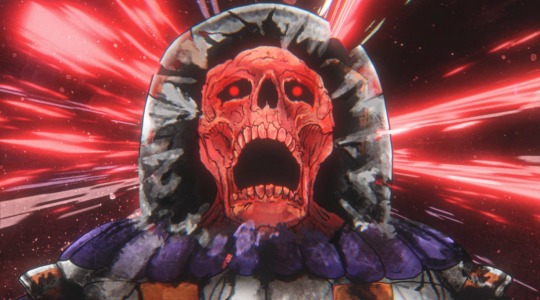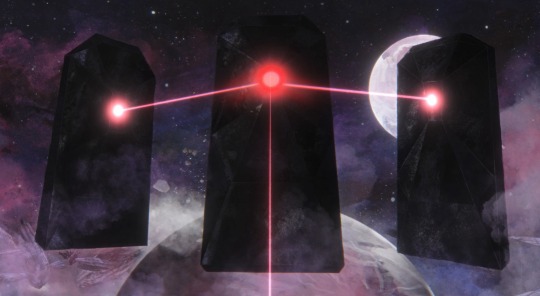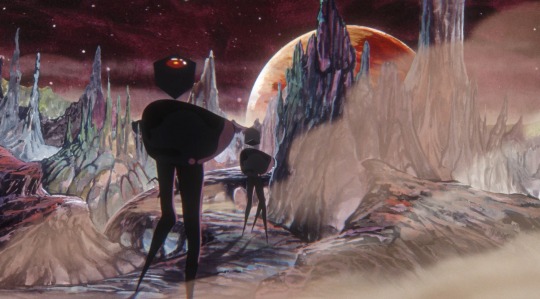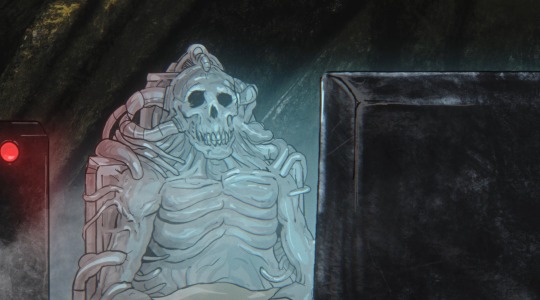#helena papageorgiou
Explore tagged Tumblr posts
Text
youtube
🎵 Jupiter 26 by All India Radio [Free Download on BandCamp including concept drawings for the video]
🎬 Music video by Helena Papageorgiou [Rough animatic here]
The video is a homage to the cinematic style of Pink Floyd legendary Echoes Live at Pompeii film. The Beastie Boys did something similar but as far as I know no one's done it with animation. Helena’s love of 1970s animators Moebius & Rene Laloux really comes through and there’s a nod to the Star Trek classic movies and TV shows that featured spooky stone circles like Doctor Who: The Stones of Blood & Children of the Stones. Martin Kennedy
#music#australian music#all india radio#martin kennedy#joe haley#simon polinski#scott targett#studio pros#artwork#jesse jacobi#video#music video#helena papageorgiou#Youtube#Bandcamp
46 notes
·
View notes
Text




Art by Jon Weber and Helena Papageorgiou from the new video of my band Observers new single Frank Poole’s Dream. Full video: https://youtu.be/_sQIsxSZoQU?si=_mg1NQCFQVPngUwr
youtube
142 notes
·
View notes
Text
Similar Creative Projects
Curiocity Brisbane is a science, arts and technology festival; it was held from March 12–28 in 2021. The festival had a collection of “curiocities,” which were both physical and digital installations displayed across four precincts: the City Botanic Gardens, South Bank, South Brisbane’s Cultural Precinct, and the Brisbane CBD (The Weekend Edition, 2021). The festival offered two experiences that resemble my project concept: Maiwar ARand Enchanted Tropics. Both projects were delivered from 8am to 8pm daily for the festival’s duration.
Maiwar AR by Bilbie Labs

Maiwar AR is an augmented reality heritage tour of Brisbane during the first contact period. It was delivered across all four precincts of the festival. Visitors were transported back in time to historical Brisbane (Maiwar), one day before European settlement (Curiocity Brisbane, n.d.b). Through their smart devices, users triggered ��virtual geospatial scenes” that conveyed a day-in-the-life of the original custodians of the land and their connection to specific areas within the landscape of the four precincts (Curiocity Brisbane, n.d.b, para. 3). Maiwar AR’s use of AR technology to create a site-specific “back-in-time” experience is similar to how I have used it in Explore. Maiwar AR deals directly with the Indigenous history of key locations on multiple sites, where Explore is unique to the Northshore site. Explore also offers a deeper educational and emotive experience as it combines AR technology with audio and textual elements to provide take users on a journey of discovery, whilst also accommodating the hard of hearing and visually impaired.
Enchanted Tropics by EyeJack and Helena Papageorgiou

Enchanted Tropics is an AR installation inspired by Queensland’s own flora and fauna. Visitors can use their smart devices to watch large cut out trees come to life with animated bugs, animals, blossoming flowers and falling leaves, each animation accompanied by a magical soundscape (Curiocity Brisbane, n.d.). It was delivered at the City Botanic Gardens. Enchanted Tropics uses AR technology to showcase local artist’s works, which is similar in Explore. However, the art in Explore will be directly related to the Indigenous and maritime history of Northshore, and thus cannot be delivered elsewhere.
Self-guided Digital Heritage Tour by Ballarat Heritage Festival, Vic

Visitors to Ballarat can take a self-guided tour of ten of the city’s diverse historical landmarks and interact with them through an AR platform activated by QR codes (Ballarat Heritage Festival, n.d.). The AR experience is complemented by an audio tour with stories about each location, told from various perspectives (Ballarat Heritage Festival, n.d.). It is accessible for all, including the visually-impaired and those who are hard of hearing. The audio tour features a Welcome to Country by a local Wadawurrung woman (City of Ballarat, 2021). I’ve used AR technology very similarly to take users on an immersive, heritage experience, but where the Ballarat Heritage Festival’s app is used across locations, mine is unique to the Northshore Maritime Green site. The stories will all be centred around the histories of Northshore. I also feature local artist’s work in the production of the visual and audio elements of the experience.
Ballarat Heritage Festival. (n.d.). Self-guided digital heritage tour. https://ballaratheritagefestival.com.au/self-guided-heritage-tour/
City of Ballarat. (2021). Ballarat Heritage Festival: Augmented reality trail. https://ballaratheritagefestival.com.au/ar/
Curiocity Brisbane. (n.d.a). Curiocity: Enchanted Tropics. https://curiocitybrisbane.com/events/enchanted-tropics/
Curiocity Brisbane. (n.d.b). Curiocity: Maiwar AR. https://curiocitybrisbane.com/events/maiwar/
The Weekend Edition. (2021, March). Curiocity Brisbane. https://theweekendedition.com.au/events/curiocity-brisbane/
0 notes
Link
Artist: Vincent Tavenne
Venue: Radio Athènes, Athens
Exhibition Title: Inner Sp ace
Date: May 23 – June 20, 2020
Organized By: Giti Nourbakhsch
Click here to view slideshow
Full gallery of images, press release and link available after the jump.
Images:
Images courtesy of Radio Athènes, Athens. Photos by Yiannis Hadjiaslanis.
Press Release:
Helena Papadopoulos: Vincent, I was looking at one of your Psycho Boxes at Giti’s place this past January and this note by Ludwig Wittgenstein came to mind: “The human character of various plants: rose, ivy, grass, oak, appletree, corn, palm. Compared with the different characters words have.”(1) Because the forms you create inside these cabinets, some of which resemble aquascapes give the illusion they are breathing, they seem alive. How does each Psycho Box come about?
Vincent Tavenne: The process with the boxes first starts with a “thing”, and then an artefact, a fabricated object which substitutes the real object. Next comes the accumulation of these artefacts, a grouping. I place them in relation to each other. When I have arrived at a certain condition or state, I stop and freeze it. I feel this composition of relations deserves protection. Of course it is a box, a black box, something like an aquarium or a stage, a mock-up, sizes are variable, proportions are variable, therefore something surreal or weird can appear. The result ought to be bigger than my plans, the result ought to astonish me. My method is based on playing, on games. Otherwise I would be bored. As a fan of the Renaissance I am aware of the cabinets of curiosities, and putting strange, extraordinary, alien things together. What happens in these boxes is the appropriation of the world. The boxes with the plants have a slightly different background. I inherited a book on flowers from my mother which she was using daily. So I started to recreate some of them. In fact, these small objects, papier maché with some wire and paint need a practical kind of protection when they are staged.
HP: The Tent Sculptures made of textiles connote nomads’ dwellings, do they relate to how thought nomadizes from language to language, culture to culture? I am thinking of your French background and the fact you have been living in Berlin for some time and how text is linked to the Latin word textum, i.e. fabric and thus to weaving, to different strands woven together.
VT: Ulrich Rückriem, with whom I studied, was always having a stress analyst check the stability of the substrate because of the heaviness of his sculptures. In a way for me this was a repellent example— to have something up which is immobile, and heavy, and difficult. Hence my reflex was simply to do the opposite, build up something for a show and have it easily disappear afterwards, avoiding difficult handling and massive storage. The sculptures made of an inner structure, a framework, and fabric have several influences. In the beginning I was playing with the French clichés abroad: the wine, the cheese, fashion, the haute couture. I made patterns for sewing, I was sewing as if I was creating drapery or a robe. From the point of view of craftsmanship it is the same, just bigger. The way the framework is constructed is important. Maybe it is my father’s influence as a car engineer that made me very aware of connections, stability, precision, the beauty of constructive solutions accorded to and in proportion to different elements that create the whole.
HP: Giti you have worked with Vincent on several exhibitions at your gallery in Berlin and the Sculpture Légère we are showing at Radio Athènes was made especially for you. How does it feel being inside it?
Giti Nourbakhsch: In our very first show, I think in 1999, Vincent exhibited a tent sculpture which we called “die Tonne”, the barrel. It was a brownish, cylindrical body, high up just below the ceiling of the space and it seemed closed from all sides. It had two entries across from each other, just a slit each. You could enter and follow a narrow path around the half round and then you would enter the center, a surprisingly completely blue space which opened up to the ceiling, like a cone. It was big enough for some people to stand there. All was blue. You would be there, for no good reason, a space of no defined function, looking up maybe. The fabric/the membranes of the sculpture would dim sounds, so it was very silent and peaceful. All this wasn’t visible from the outside. One day my dog Susi, a tall Great Dane, disappeared and I was looking for her everywhere. I found her sleeping in the centre of the blue space. She must have walked all the way the inside path to get there. I don’t know why she did it, except that she was special anyway, for example she was enjoying the loud overtone concert of Charlemagne Palestine, lying next to his feet, too. Indeed, the inner space of the barrel was a very pleasant place to be in. Nothing to do, no intentions. Many years later, I asked Vincent to create an inner space for me, as pleasant as the blue centre of the barrel, where I would go, like Susi did and just be. As a fan of the colour pink, I wished for a space where I could put a bed with pink daylight. Vincent created a “double barrel”, two cylindrical forms fusing together. Looking from above they have something of an 8, from the outside something of boobs or bottom cheeks. It was funny, the entrance slits were right where the round forms met, as if you entered through the boobs or the bottom cheeks. You would follow a narrow path again and would enter a center, this time with a red closed ceiling, a kind of gossamer. The outside light would reflect into the inside, so my wish to have pink light inside was fulfilled. I had this bulky object up in my living room for a long time. It questioned, just by being there, how I lived, questioned the sofa, the doors, the coming and going…It was nice to have it in the apartment like a big weird animal. I used it as a reminder that most things and activities are conventions and agreements. A big bulky thing to remind me of the gap, the hiatus. Sculptures can do that. By absorbing and occupying space, they can remind one of emptiness, in a philosophical kind. You don’t think it, you “feel” philosophical. The surrounding sound was dimmed again. (After I took it away, the apartment seemed empty and sadly rational.) For a while I pinned photos and objects in the inside space. You could also lift the “walls” and have it semi-open.
HP: Vincent, you mostly use natural materials in your work, hand-dyed fabrics, wood, paper. And there are some shapes that keep recurring like the circle and the square. Some of your exhibition titles like “Univers”, “Stratosphère”, “Ether”, “Beginning”, “Black Hole” suggest a reflection on the origin and development of the cosmos. The title you chose for this exhibition in Athens is “Inner Sp ce”. The letter a is missing, and I see your tent rising in the empty space between the letter p and the letter c.
Another thing that can’t be left unsaid is that you started making these series of sculptures where you typically use wooden supports and various textiles more than twenty years ago. That was before the migrant crisis which brought another complexity to what the tent signifies. All this to ask, how do you perceive your work as an artist in relation to a world that seems particularly fragile at this moment in time? VT: To give a possible answer to both questions above: My interest in the cosmos, the universe and so on, gives me the pleasant feeling of just being a tiny crumb of a bigger picture. That’s nice. All is changing, unstable at all times. I hope my empathy for those forced to be nomadic, to live a provisional life is perceptible. Konstantinos Papageorgiou: First of all apologies for joining this exchange with considerable delay. In the meantime, you have all seen your branches grow and created an interesting texture of meanings and now I am about to enter and tear this fine web apart. On the other hand, nothing will come out, if we do not stretch our potential and attempt to create something new. Nothing will come out just by staring at something. A new tension, a leap of faith and a gesture of love are asked for. So, we are constantly taking epistemic and emotional risks. Good art is the best reminder of the fact that we are alive and that we need to move within space and time and most importantly “move” within our inner time and space —if we want to be free. Good art is an “awakening of the sleepers” which is something more than just rendering us conscious of x or simply making us believe that y, or perhaps making us hopeful or afraid of z. In that sense, I find the points that have been raised so far very pertinent. The tent structure you are preparing for Radio Athènes, Vincent, already seems to be claiming a part of my own inner space and making me anticipate it in “real”. It has transformed me already. But since I am expected to ask a question (in a sense, I think I already made my point!) I wish to take the discussion back to two works of yours I have seen from close up and admire. The one is “Feu” (Fire), the amazingly monumental and beautiful woodblock print of tongues of fire, with many references to far eastern cosmologies but also printing techniques. The other is the small green sculpture of a plant— is it a nettle, I wonder ? —that appears as a kind of manifestation of an eternal cycle of life. What does this juxtaposition imply? Somehow I have the feeling that the little root is a reminder of sorts (think of the spinning totem in Christopher Nolan’s Inception), of an objective world within which we do live and cannot escape whereas the stylized tongues of fire, variably stenciled, refer to the fluidity and potential of our inner emotional, spiritual, intellectual worlds. Does this make any sense to you at all?
GN: Martin Schuettpelz, who owns a tent sculpture by Vincent, is an architect and among his other projects he constructs Dan Graham’s pavilions, hence he is used to tricky architectural structures. Having the tent in his house, he said, he still doesn’t know what it is. With Martin’s permission, I would like to present his untranslatable German poem/text relating to it:
Blaustoff isst Rotschopf Goldener Flachs Hospital auf Häkelkissen wie oft geht rundes Fenster Rost im Wasser Bleiverglasung auf Leder weiß Schrauben im Selbstdrehpack weichen Felsen schwarz angucken war nicht Blau der Mond Fischgrät nach Zimmergröße Baguette hinter Glastür die Latte falsch flicken Gewinde ohne Filzteller Flechten hoch auf 360° Kiloweise Zweitonnenhans Flechtenkur Rasenbleiche, andere Bilder suchen Asphaltbruch über Pappelwurzel
Fliesenholz, salonfähig, Stuckmarmor Saptil Tellerrand auf Obstkiste nach dem Schild schauen und nicht folgen nummern nach dem Zusammenbauen mehr Alphabete Falten für den Strich Pixelreihe auf gebogener Linie
Kratzer im Parfüm Waschmaschinenblech gedengelt Senkel, gesäumt krüselig gespannt ruibarbo para Mexico Birne durchs Loch hängen Lattenspagat Kleidersaum mit Staubflaum Nebelkabinett in Blaumilchstrumpf
Giti Nourbakhsch is an experimenting former art dealer, she lives and works in Athens. Helena Papadopoulos is a writer and curator and the founding director of Radio Athènes. Konstantinos Papageorgiou teaches Philosophy of Law at the Athens University Law School, he lives and works in Athens. Vincent Tavenne (*1961) is an artist, he lives and works in Berlin. He was born in Montbéliard, France and studied at the Kunstakademie Düsseldorf. Vincent Tavenne has shown internationally including at Kunstverein Rastatt and Oldenburger Kunstverein, Oldenburg (2020); Centre Pompidou-Metz/France (2016); Museum am Ostwall, Dortmund (2015); Saarlandmuseum, Saarbrücken (2010); Kunstverein Lübeck / OverbeckGesellschaft (2008); Sammlung Grässlin (2007); Kunstverein Arnsberg (2004); Kunstverein Braunschweig (2001); Hamburger Bahnhof Museum für Gegenwart, Berlin (1998). Since 1994 he has had solo exhibitions with Galerie Hammelehle und Ahrens, Stuttgart/Cologne; Galerie Daniel Buchholz, Cologne; Galerie Giti Nourbakhsch, Berlin and Adamski, Berlin. Selected publications include “Polarise-Toi” on the occasion of the titular exhibition at Saarlandmuseum, Saarbrücken, published by Hatje Cantz Verlag (2010) and “Hundert Fragen und Keine Antwort” a monograph on the occasion of his solo show at Kunstverein Braunschweig published by Walther Koenig Verlag. He was the recipient of the Villa Romana Prize, Florence.
In May hours are Wednesday 4-8 pm, Saturday 12-4 pm, in June every Wednesday 4-8 pm and by appointment.
Please book a slot by sending a message a day in advance [email protected]. Radio Athènes is supported by Outset Contempory Art Fund (Greece)
(1) Ludwig Wittgenstein, Culture and Value, Translated by Peter Winch, The University of Chicago Press, Chicago, 1984, p.23c
Link: Vincent Tavenne at Radio Athènes
from Contemporary Art Daily https://bit.ly/30tKmUx
0 notes
Video
vimeo

Deep Blue by All India Radio featuring Sasquin - Video by Helena Papageorgiou
#music#australian music#all india radio#sasquin#anna waugh#severn duo#tom mccluskey#jess townsend#wolfybass#chris brush#video#animation#music video#helena papageorgiou#martin kennedy
27 notes
·
View notes
Text
Preview of the video by hp_econdvariety for ‘Mexicola’ from the forthcoming double vinyl edition of my band All India Radio’s 2006 album Echo Other, on vinyl for the first time. Limited edition pre-order here
#space art#all india radio band#echo other album#mexicola single#science fiction#anime#animation#retro#1980s
33 notes
·
View notes